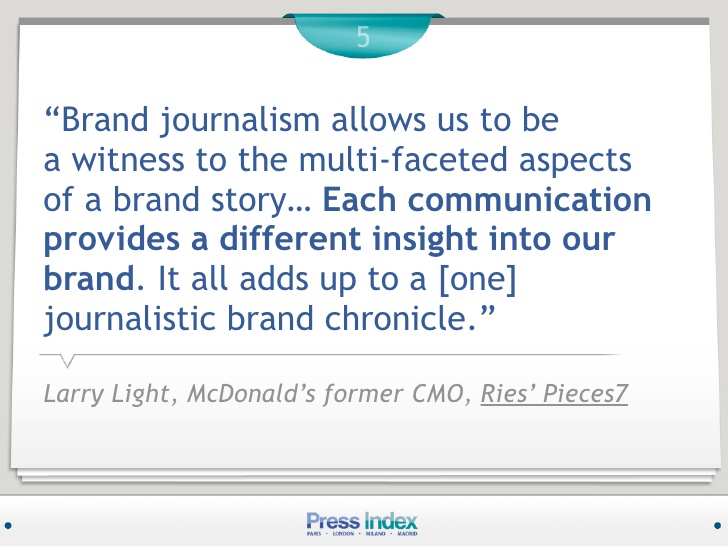By Matt Pigott - October 20th, 2015

If brand journalism is on the rise, thank McDonald’s for laying its foundations a little more than a decade ago.
By being the first major company to share behind-the-scenes stories with an increasingly skeptical and cynical public, it inadvertently coined a new style of marketing—one that helped turn its own flagging fortunes around.
Back in 2004 brand journalism arrived, directly or indirectly, as a response to a tidal wave of negative publicity, the apex of which was Morgan Spurlock’s award-winning documentary, Supersize Me. In it, the writer-director eats nothing but McDonald’s food for 30 days. Naturally enough, by eschewing a balanced diet and gorging on burgers, fries, and shakes for a whole month, he became overweight, listless and– according to his then wife–stricken with a depleted sex drive.

Managing the fallout
After the film, McDonald’s had to parry intense negative press and public outrage. For companies faced with situations such as this, it’s impossible to gauge how far the whirlwind of negative coverage will go, and how destructive it will be. But one thing’s for sure, sitting back and doing nothing while shareholders fume is never an option. McDonald’s beacon of hope, it turned out, was Larry Light, CMO at the time, who wielded ‘brand journalism’ as his defense weapon of choice.
Trust through transparency
A new focus on transparency began, and what began as a measured response to the problem became an ongoing strategy that continues to underpin McDonald’s marketing today.
More recently, by turning the lens on its supply chain through a series of short films that tell human stories about, for example: potato supplier Frank Martinez; apple supplier Leo Dietrich; and fish supplier Kenny Longaker, among others. McDonald’s gave consumers a more rounded view of the company, taking them beyond the restaurants that serve up its food into the fields, oceans, and orchards where its suppliers operate.
Taking even bigger myth-busting steps, the company also—quite daringly—allowed cameras into its factories to film the various stages in the making of Chicken McNuggets. Our Food, Your Questions demystifies McDonald’s back-end processes by delivering a visual overview of the specific parts of the chicken that are used in the nuggets, along with a breakdown of ingredients that make up nuggets’ batter.
Real journalism or PR puff?
Whether all of this is true transparency or truly exceptional PR is open to debate. But what it is, indisputably, is a real look into backrooms that have previously been hidden from public view. Whether consumers like what they see or not is immaterial; after the terrible flak McDonald’s has had, this sort of rare ‘journalistic’ insight has helped the company to claw back trust and debunk a host of damaging misconceptions. And it has achieved this through transparency, and dialogue generated by Larry Light’s brand journalism vision.
Says Light:
“We have evolved from monologue to dialogue to ‘multi-logue’ communications.”
Which means the real task for companies today isn’t to drum up snappy one-liners and hit people over the head with them until they buy something, but to deliver a steady flow of content that consists of videos, blogs, articles, events, seminars, and well-coordinated social media campaigns.

Frontline tweets
According McDonald’s social media manager, Rick Wion, monitoring the tone and timbre of Twitter conversations is now a key part of the company’s communication strategy, enabling the brand to stay on point with its day-to-day messaging and keep its brand story fresh and relevant.
Interestingly, Wion also points out that “the best tweeters are the best writers.” At a time when brevity remains a revered journalistic skill, is it possible that these ‘writers’, restricted as they are to 140 character posts and responses, are in fact modern day journalists who could become pivotal to the company’s future communication strategy (if, indeed, they aren’t already)?
Whether tweeters are brand journalists remains an open question, but one thing is clear: against a backdrop of multiple, fast-moving conversations, brands care less about one-way catchphrases, and more about real-time conversations that develop relationships and, by turns, impact future growth and profits.
If this is brand journalism, or an aspect of it, McDonald’s is taking it seriously. If nothing else, the last decade has demonstrated that, even with the world’s biggest fast-food franchise, news can be punishing, but it can also drive creative marketing minds to come up with innovative solutions.
You can learn more about the future of brand journalism at the upcoming Incite Summit: East in New York, November 12th and 13th.
Next Reads
November 2015, The Marriott Brooklyn Bridge
The USA's best brand-focused marketing conference. Featuring CMOs, SVPs and marketing leaders from Dell, Citi, Chobani, Activision, HSBC, Mondelez and many more.
Brochure Programme